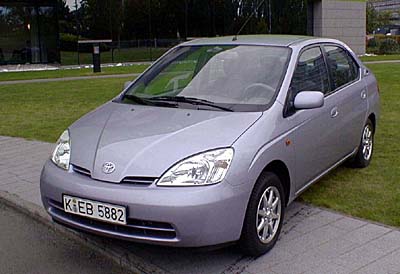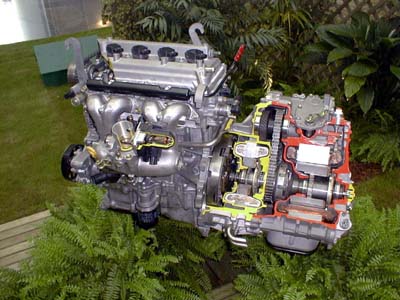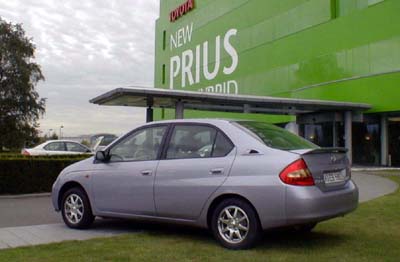Proud Prius is green Toyota

22 September 2000: by Brian Byrne.
It's not a new concept - the world's first mass-produced 'hybrid' car has been on sale in Japan since late 1997, but it is now officially here in Europe. In Ireland, the Toyota Prius will go on sale in November.
A new term for the motoring consumer, 'hybrid' means a mixture of power units in the one vehicle. In this case, a normal 1.5-litre engine along with an electric motor. Both are used to drive the wheels, sometimes together, sometimes one or the other. The important thing is that there's considerably better fuel consumption. The REALLY important things is that the main emission pollutants are reduced by up to 90% as against a normal petrol-powered car in the class.
The first thing to say clearly is that the Prius is a REAL car. It looks like a car, it goes and stops like a car, and without prior knowledge that it is something unusual, many drivers would hardly notice the driving differences.

In the Prius, the electric motor does the propelling much of the time in city work, with the petrol engine only cutting in if extra power is suddenly needed, or the battery needs recharging. Out on the highway it's the other way around, with the petrol engine providing cruising power and the electric motor only dropping in when extra load comes on, such as in overtaking.
You don't have to worry about it, because the crossover in every driving condition is seamless, managed by a highly-developed computer-managed power split device. The transmission is a CVT automatic, and there's another plus - where in an ordinary car you waste energy when you apply the brake, in the Prius that braking energy is used to help recharge the battery.
The battery itself is a Nickel Metal Hydride type, and in the 'second generation' Prius it is 60% smaller and 30% lighter than the one used in the original car, of which 40,000 have been sold in Japan.
For Europe, the latest version of the car has also had suspension improvements and a few small cosmetic changes.
On the fuel economy matter, the claimed consumption on the combined cycle is 5.1 litres per 100km. For comparison, the 1.3-litre Yaris uses 6.1 litres/100km, and the Prius has the interior dimensions of the next level class, the Avensis.
The Prius starts up slightly differently to a normal car, with no engine or motor noise until you actually start moving (the petrol engine is switched off whenever there's no or just low load).
It's all very quiet until you look for serious power, and then the petrol engine comes on line. First impression here was that there's perhaps room for a little more soundproofing of that unit, or maybe it's just that the car is otherwise so quiet.
The 'go-feeling' is just that which an increasing number of us have got used to with CVT transmissions and their complete lack of gear 'shift' sensation. I like it.
Otherwise, the Prius drives completely normally, with the only other odd sensation being when you brake, and feel the slow-down effect of the generator cutting in. The brake regeneration is the primary stopping mechanism, with the hydraulic brakes augmenting it. The car has discs all around.
In other 'normal' car areas we have the usual for the Prius - ABS brakes with electronic brake distribution, dual airbags, specially-designed 'anti-whiplash' seats and all the rest. The Prius is well-finished, with good plastics and suede-type seatcoverings. The digital instruments pod is set just under the windscreen, and a screen in the centre stack has a graphical display of just which technologies are working at the moment. The screen also displays the satellite navigation system where installed, as it was in the test cars.
The car is roomy both front and rear, and very comfortable. It comes with air-conditioning and power steering both powered, naturally, by electricity.

Externally the Prius is fairly sober in style, not at all trying to flaunt its inner technology by futuristic sheetmetal. Indeed, some could call it a bit old-fashioned. Though the interior dimensions are close to those of the Avensis, it is about the same as a Corolla externally. It is tall, one way of packaging more people into a given length of car.
The boot space is surprisingly good too, given that the battery also lives just behind the rear seats.
There are obviously a few questions about the Prius which potential customers wouldn't have to ask about another car. The battery is one of them ... how long will it last, and how much to replace? Well, it is, according to Toyota, designed to last the life of the car, which is reckoned to be about 10 years. And it is covered by the five-year warranty with the Prius. As to the battery cost, it is currently around £2,500, but Toyota believe this will come down substantially by the time anyone needs to worry about paying for a replacement.
So what price all this 'green' technology in a real working, buyable car? Expensive enough, unless the Government puts its money where its green mouthing is. Though the Taoiseach, Tanaiste, and finance and environment ministers have privately said they're 'positively disposed' towards the car, Toyota Ireland has not yet been able to make any headway with them on actually giving some kind of tax break.
So the company hasn't felt able to give us a line on the price here yet. It may well be that, unlike some other enlightened administrations in Europe, the inate greed of our Celtic Tiger politicians simply won't allow them eschew a few euros of tax on what won't be, for a while anyway, be a large number of cars.
It's a good bet that they're actually afraid to loosen the tax leash on something like the hybrid technology, for fear that it will be used much more and they'll lose out on a larger scale later.
The Belgian price announced last week is £17,400, and compares in Belgium to the £16,400 for a 1.8-litre automatic Avensis, or around £14,900 for an automatic 1.8 Passat. Make the adjustments for Irish price levels and we're looking at £20,000-plus for the Prius.
Not too many individuals, no matter how green their souls, are going to fork out that money for a car that looks the same size and class as a Corolla. It's going to be down to companies who want to promote a green image, to buy the 50 or so Prius cars Toyota Ireland expects to sell next year(the total for Europe is expected to be 5,000, and there's been very strong pre-sale interest in the US).
The ESB, VHI and Guinness have already expressed interest at home. Any government officials? Not yet. After all, they're only going to make £600,000 in taxes on those same 50 cars. No point in spending any of it on a real effort to clean up the environment, is there?
For those of you interested enough to see what green does for performance, the Prius has a 0-100kph of 13.4 seconds, not blinding but not a slouch, either. It has a maximum speed of 160km/h.
Bluntly, oil is going to get scarcer and more expensive over the next 10 years. Many alternative technologies and fuels are being investigated and developed. The hybrid idea, particularly in the form developed by Toyota, is one intermediate step towards a fairly radical change in private car propulsion systems for the coming decades.
It will be interesting to see how it is received, by politicians and consumers alike. But it's a foregone conclusion that there won't be too many of the latter without some movement by the former.
Prius facts: 1.5-litre petrol plus electric motor; CVT; Saloon; price range £20,000-plus?.
 A KildareNet News production by Telling Tales Ltd, PO Box 106, Naas, Co Kildare, Ireland. Tel 086 8267104. Fax 045 481091. Email A KildareNet News production by Telling Tales Ltd, PO Box 106, Naas, Co Kildare, Ireland. Tel 086 8267104. Fax 045 481091. Email |
